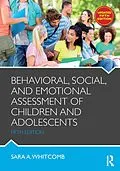Generally recognized as the standard work in its field, Behavioral, Social, and Emotional Assessment of Children and Adolescents is a comprehensive guide for conducting conceptually sound, culturally responsive, and ecologically oriented assessments of students' social and emotional behavior. Written for graduate students, practitioners, and researchers in the fields of school psychology, child clinical psychology, and special education, it will also be of interest to those in related disciplines. Building on the previous editions, this fifth edition includes updated references to DSM-5 and federal standards as well as an integrated approach to culturally competent assessment throughout the text.
In Part I, Foundations and Methods of Assessment, the author provides a general foundation for assessment practice and outlines basic professional and ethical issues, cultural considerations, and classification and diagnostic problems. Part II, Assessment of Specific Problems, Competencies, and Populations, includes material on assessing specific social-emotional behavior domains, including externalizing problems, internalizing problems, social skills and social-emotional strengths, and the unique needs of young children. A chapter on school-wide screening methods was also added with this edition. By weaving together the most recent research evidence and common application issues in a scholarly yet practical matter, Behavioral, Social, and Emotional Assessment of Children and Adolescents continues to be the pre-eminent foundation for assessment courses.
Autorentext
Sara A. Whitcomb is Associate Professor in the College of Education at the University of Massachusetts, Amherst, USA.
Zusammenfassung
Generally recognized as the standard work in its field, Behavioral, Social, and Emotional Assessment of Children and Adolescents is a comprehensive guide for conducting conceptually sound, culturally responsive, and ecologically oriented assessments of students' social and emotional behavior. Written for graduate students, practitioners, and researchers in the fields of school psychology, child clinical psychology, and special education, it will also be of interest to those in related disciplines. Building on the previous editions, this fifth edition includes updated references to DSM-5 and federal standards as well as an integrated approach to culturally competent assessment throughout the text. In Part I, Foundations and Methods of Assessment, the author provides a general foundation for assessment practice and outlines basic professional and ethical issues, cultural considerations, and classification and diagnostic problems. Part II, Assessment of Specific Problems, Competencies, and Populations, includes material on assessing specific social-emotional behavior domains, including externalizing problems, internalizing problems, social skills and social-emotional strengths, and the unique needs of young children. A chapter on school-wide screening methods was also added with this edition. By weaving together the most recent research evidence and common application issues in a scholarly yet practical matter, Behavioral, Social, and Emotional Assessment of Children and Adolescents continues to be the pre-eminent foundation for assessment courses.
Inhalt
Table of Contents
List of Tables
List of Figures
Preface
Acknowledgments
Part I Foundations and Methods of Assessment
Chapter 1. Foundations of Assessment
Theoretical Foundations of Social and Emotional Behavior Social Cognitive Theory: An Integrated Orientation
Components of Social Cognitive Theory
Triadic Reciprocality: Understanding the Determinants
of Behavior
Observational Learning: A Multiprocess Analysis
The Importance of Context: Ecological Systems Theory
Finding Your Own Theoretical Foundation
Philosophical Foundations of Assessment Nomothetic and Idiographic: Definitions and Historical Development Nomothetic and Idiographic Approaches in Practice Empirical Approach to Assessment
Understanding and Clarifying Assessment Referrals
Assessment as a Problem-Solving Process
A Model for Assessment as a Problem-Solving Process
Phase I: Identification and Clarification
Phase II: Data Collection
Phase III: Analysis
Phase IV: Solution and Evaluation
Designing a Multimethod, Multisource, Multisetting Assessment
Response to Intervention (RTI): A Public Health Approach to
Assessment and Intervention
Legal and Ethical Issues in Assessment
Basis for Legal Constraints on Assessment
Specific Assessment Practices Affected by Ethics and Law
Informed Consent
Validity of Assessment Procedures
Right to Privacy/Confidentiality
Some Concluding Comments on Legal and Ethical Issues
Criteria for Inclusion of Assessment Methods and Instruments
Conclusions
Review and Application Questions
Chapter 2. Social-emotional Assessment and Cultural Diversity
Test and Assessment Bias in Professional Practice
Test and Assessment Bias
Professional Ethics and Culturally Appropriate Assessment
Professional Practice
Acculturation and Identity Development
Factors That Influence Acculturation
Determining Acculturation and Cultural Orientation
Development of Racial/Cultural Identity
Stage 1: Conformity
Stage 2: Dissonance
Stage 3: Resistance and Immersion
Stage 4: Introspection
Stage 5: Integrative Awareness
Problems with Categories and Group Emphasis
Cultural Diversity in the United States: Description of Major
Racial/Ethnic Groups
African Americans
Asian Americans
Hispanic Americans
Native Americans
Some General Characteristics of the Majority Culture
Assessment Methods and Cultural Diversity: Special Considerations
Behavioral Observation
Behavior Rating Scales
Interviewing
Learn About the Interviewees' Culture
Learn About the Interviewees' Language
Establish Rapport
Identify Stereotypes
Promote Clear Communication
Identify Family Needs
Identify Attitudes toward Health and Illness
Recognize the Extent of Acculturation
Accept the Interviewees' Perspectives
Sociometric Techniques
Self-Report Instruments
Projective-expressive Techniques
Recommendations for Culturally Competent Assessment
Conclusions
Review and Application Questions
Chapter 3. Assessment and Classification
Why Classify?
Differential Diagnosis and Classification Error
Current Classification Systems
DSM System
Assumptions and Structure of DSM
Using the DSM System in Assessment
Improvements and Changes in DSM
Classification under Special Education Law
General Assessment Guidelines in the IDEIA
IDEIA Definition of Emotionally Disturbed
ED versus SM Issue
State Adaptations of the Federal Definition
New Directions
Behavioral Dimensions: An Alternative Approach to
Classification
Behavioral Dimensions and the ASEBA System
Example of Behavioral Dimensions Approaches to
Specific Classes of Behavior
Additional Comments on the Behavioral
Dimensions Approach
Multiple-Gating Approaches to Assessment and
Classification
Community- and Clinic-Based Multiple-Gating
Procedure
SSBD: A School-Based Multiple-Gating Procedure
SARS: Classification of Behavioral Problems Using
Existing School Records
Concluding Comments on Assessment and Classification
Conclusion…
